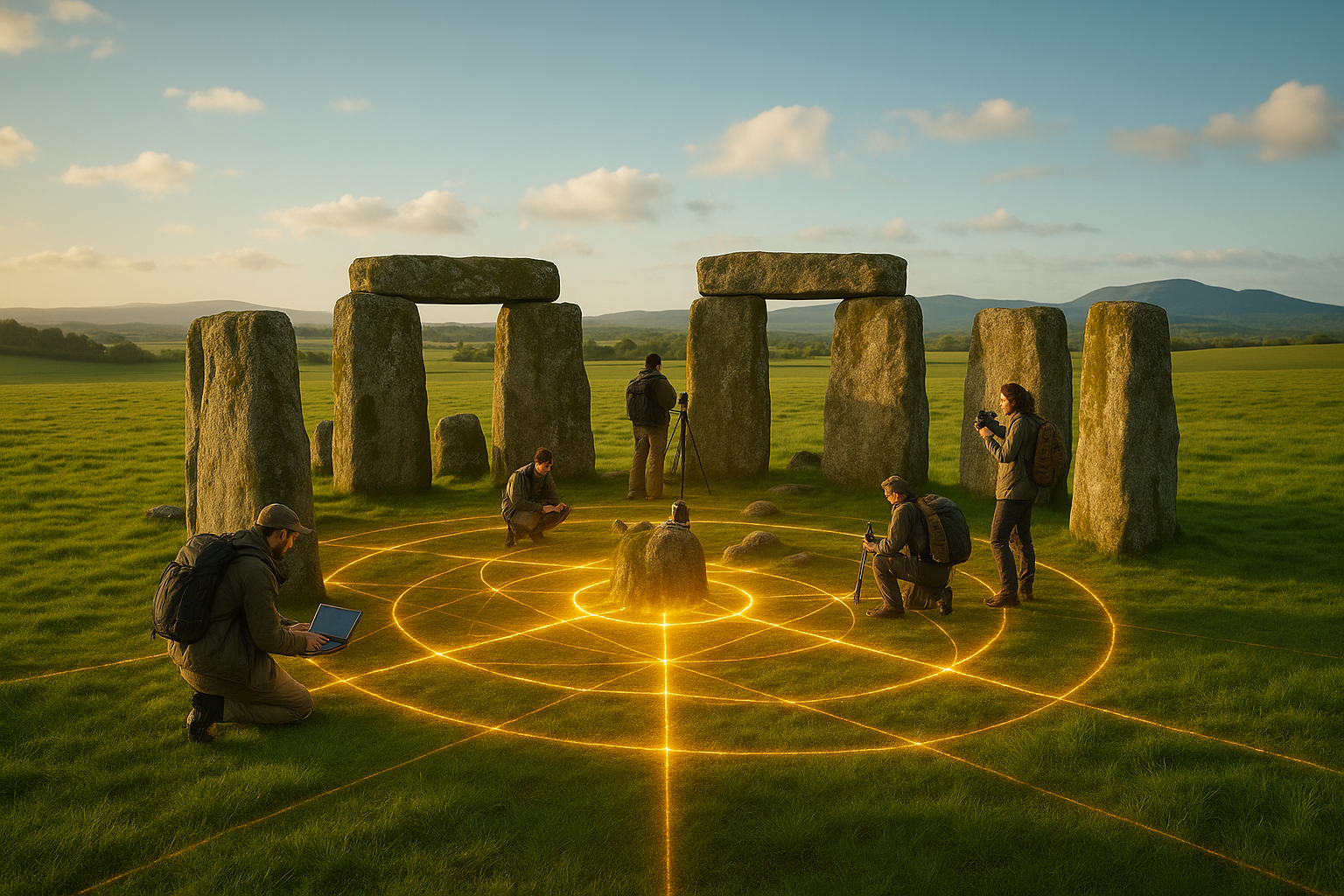In a world where technology evolves at a pace faster than we can sometimes comprehend, it’s easy to overlook the ancient, silent sentinels that have stood the test of time — stones. These seemingly ordinary objects have borne witness to the ebb and flow of civilizations, holding within them stories as old as the Earth itself. From the majestic pyramids of Egypt to the enigmatic Stonehenge in England, stones have not only shaped our landscapes but also our understanding of the past. They are the original storytellers, chronicling the history of humanity and nature alike. But how often do we pause to consider the tales they could tell if only we knew how to listen? 🌍
Unlocking the secrets of stones is akin to learning a new language, one that is written in the etchings of erosion, the layering of sediments, and the precise geometry of crystalline structures. In this journey through time, we’ll delve into the fascinating role stones have played as keepers of memory. We will explore the scientific techniques that allow us to interpret the geological and archaeological records locked within these natural archives. From radiometric dating that tells us the age of rocks with astounding precision to the study of fossils that reveal life forms from eons ago, stones provide a window into eras long past. Furthermore, we’ll examine the cultural and spiritual significance of stones in various societies, uncovering how they’ve been revered as symbols of permanence and resilience.
As we embark on this exploration, we’ll also consider the contemporary relevance of stones in our ever-changing world. What can they teach us about climate change, resource management, and sustainability? How do stones inspire art, architecture, and even our sense of identity? By the end of this article, you will have not only gained an appreciation for these remarkable natural time capsules but also an understanding of their crucial role in both preserving the past and informing the future. So, let’s set off on a journey through the ages, where stones are our guides, whispering the secrets of a world that once was and hinting at what is yet to come. 🏞️
The Ancient Significance of Stones
Stones have played a significant role throughout human history, serving as tools, symbols, and even as record keepers of our collective past. Their durability and timelessness make them unique witnesses to the evolution of life on Earth. As the world progresses, it is crucial to understand the historical significance and enduring power of these natural elements.
For ancient civilizations, stones were more than just inanimate objects; they were revered as symbols of strength, stability, and permanence. Many cultures across the globe, from the Egyptians to the Mayans, utilized stones in constructing monumental structures such as pyramids and temples. These structures not only showcased their architectural prowess but also stood as enduring testaments to their civilizations.
The geological study of stones, known as petrology, reveals that they are formed through complex natural processes that span millions of years. Their composition and formation are often reflective of the Earth’s history, providing insights into the environmental conditions of past eras. Petrology allows scientists to unlock the secrets held within these stones, offering glimpses into historical climate patterns, tectonic shifts, and even the origins of life itself.
Stones as Cultural Symbols
Stones have transcended their physical properties to become powerful cultural symbols. Different cultures have ascribed various meanings to stones, reflecting their beliefs, values, and traditions. In many societies, stones are considered sacred, imbued with spiritual significance and revered as connections to the divine.
In Hinduism, for example, the Shaligram stone is considered a manifestation of Lord Vishnu and is worshipped with great devotion. Similarly, in Christianity, the cornerstone is often seen as a metaphor for Christ, representing a foundation of faith and strength. These cultural interpretations illustrate how stones have been integrated into spiritual practices and belief systems worldwide.
Moreover, stones have also been used as markers of identity and heritage. The intricate carvings found on ancient stones often depict stories, genealogies, and important events, serving as a form of historical record-keeping. These engravings provide valuable insights into the social, political, and religious dynamics of past civilizations, helping us understand our cultural evolution over time.
The Mystical Powers of Stones
Stones have long been associated with mystical properties and healing energies. Many cultures believe that certain stones possess unique powers that can influence human emotions and well-being. For instance, amethyst is often considered a stone of protection and is believed to promote calmness and clarity of mind. Similarly, rose quartz is associated with love and healing, thought to foster compassion and emotional balance.
The practice of using stones for healing purposes, known as crystal healing, has gained popularity in recent years. Proponents of this alternative therapy claim that stones can absorb, focus, and direct energy, helping to balance the body’s natural vibrations. While scientific evidence supporting these claims is limited, the psychological benefits of using stones as symbols of positive intentions cannot be discounted.
This enduring belief in the mystical powers of stones underscores their significance beyond mere physical attributes. Whether through spiritual rituals, meditation, or simply as decorative items, stones continue to captivate the human imagination, serving as reminders of the profound connection between nature and human experience.
Stones in Modern Science and Technology
While stones hold immense cultural and historical significance, they also play a vital role in modern science and technology. Advances in geology, mineralogy, and materials science have expanded our understanding of stones and their applications in various industries.
The study of minerals within stones has led to groundbreaking discoveries in areas such as electronics, construction, and healthcare. For instance, silicon, derived from quartz, is a fundamental component in the production of semiconductors, essential for the functioning of electronic devices like smartphones and computers. Similarly, the strength and durability of granite and marble make them popular choices for construction and interior design.
The mining and extraction of valuable minerals and gemstones from stones have significant economic implications. The global gemstone market, valued at billions of dollars, continues to thrive, driven by the demand for jewelry, decorative items, and industrial applications. Understanding the properties and origins of these stones is crucial for ensuring sustainable practices and ethical sourcing.
Stones and Environmental Impact
The extraction and use of stones also raise important environmental considerations. Mining activities can have detrimental effects on ecosystems, leading to habitat destruction, soil erosion, and pollution. It is essential to implement responsible mining practices that minimize environmental impact and prioritize sustainability.
Efforts are underway to develop eco-friendly alternatives and technologies that reduce the reliance on traditional stone extraction methods. Innovations in recycling and synthetic stone production offer promising solutions, allowing for the creation of high-quality materials while preserving natural resources. These advancements highlight the need for a balanced approach that considers both economic growth and environmental conservation.
Innovations in Stone Utilization
As technology advances, so do the possibilities for utilizing stones in innovative ways. Researchers are exploring new applications for stones in fields such as renewable energy, nanotechnology, and medicine. For example, certain stones have been identified as potential catalysts for chemical reactions, offering promising avenues for clean energy production.
In the realm of medicine, minerals derived from stones are being studied for their potential therapeutic properties. Calcium carbonate, commonly found in limestone, is used in pharmaceuticals and dietary supplements, providing essential nutrients for bone health. These developments demonstrate the versatility of stones and their potential to address some of the most pressing challenges of our time.
Preserving Stone Heritage
The preservation of stone heritage sites is a critical aspect of maintaining our connection to the past. Many ancient structures and monuments are at risk of deterioration due to natural and human-induced factors. Preserving these sites requires a collaborative effort between governments, conservation organizations, and local communities.
Conservation efforts often involve meticulous restoration processes, using traditional techniques and materials to maintain the authenticity of these structures. Advanced technologies such as 3D scanning and digital modeling also play a significant role in documenting and preserving stone heritage, allowing for accurate reconstructions and virtual explorations.
The significance of stone heritage extends beyond cultural and historical value. These sites often serve as educational resources, offering valuable insights into ancient engineering, architectural techniques, and artistic expressions. They also contribute to local economies through tourism, creating opportunities for cultural exchange and economic development.
Community Involvement in Conservation
Engaging local communities in the conservation of stone heritage is essential for ensuring its long-term sustainability. Community involvement fosters a sense of ownership and pride, encouraging individuals to actively participate in preserving their cultural heritage. Initiatives such as heritage education programs, workshops, and volunteer opportunities empower communities to take an active role in conservation efforts.
Furthermore, sustainable tourism practices can help generate revenue for conservation projects while promoting cultural awareness and appreciation. Responsible tourism ensures that visitors can experience stone heritage sites without compromising their integrity, contributing to the preservation of these treasures for future generations.
Challenges and Opportunities
The preservation of stone heritage is not without challenges. Climate change poses significant threats to these sites, with rising temperatures, increased humidity, and extreme weather events accelerating their deterioration. Addressing these challenges requires innovative approaches and international collaboration to develop adaptive conservation strategies.
Despite these challenges, the preservation of stone heritage presents unique opportunities for fostering cultural dialogue and promoting global cooperation. By recognizing the universal significance of stones as memory keepers, we can bridge cultural divides and work together to protect our shared heritage.
As we continue to explore the mysteries and wonders of stones, it is essential to acknowledge their enduring impact on our past, present, and future. Whether as symbols of cultural identity, sources of scientific innovation, or witnesses to history, stones remain steadfast guardians of our collective memory, reminding us of the timeless stories they hold.
Watch this insightful video on stone preservation: The Secrets of Ancient Stone Structures – National Geographic

| Culture | Stone Symbolism |
|---|---|
| Hinduism | Shaligram stone as a manifestation of Lord Vishnu |
| Christianity | Cornerstone as a metaphor for Christ |
- Amethyst: Considered a stone of protection and clarity
- Rose Quartz: Associated with love and emotional healing
- Silicon: Fundamental in electronics production
This article delves into the multifaceted role of stones, exploring their historical, cultural, and scientific significance. Through understanding stones as memory keepers, we uncover the stories of our past and discover the potential for innovation and preservation in our future. 🌍✨
Toni Santos is a visual storyteller and symbolic naturalist whose creations explore the hidden ecologies and forgotten bonds between humans and nature, as whispered through ancient lore. Through an intuitive and myth-sensitive lens, Toni reveals the sacred choreography between flora, fauna, and human spirit — a world where trees once spoke, rivers remembered, and every herb carried a secret name.
His journey is rooted in the esoteric — in the rituals of forest-dwellers, the botanical codes of shamans, and the unspoken pacts that shaped how ancient peoples lived in deep, reciprocal harmony with the natural world. From sacred groves to serpent-guarded springs, each of Toni’s works reflects a symbolic relationship long obscured by modern forgetfulness.
With a background in visual design and ancestral aesthetics, Toni merges storytelling with sacred ecology. His pieces don’t simply illustrate — they channel. Drawing from myth, mysticism, and lost herbal traditions, he crafts visuals that resonate with the old wisdom: that nature is not background, but kin.
As the creative spirit behind Vizovex, Toni shares collections, visual studies, and articles that illuminate the occulted connections between human life and the wild world. His work calls on us to remember — not just with the mind, but with the senses and the soul — the profound dialogues our ancestors once had with earth, plant, and animal.
His work is a tribute to:
The mythic language of trees, stones, and roots
Forgotten pacts between healers and the wilderness
The sacred knowledge carried in nature’s unseen patterns
Whether you’re a seeker of ancient plant-lore, a mystic attuned to seasonal cycles, or simply someone who hears the forest speak, Toni welcomes you to wander a space where symbolism, nature, and spirit entwine — one myth, one leaf, one vision at a time.





